Different types of EV’s
There are three types of electric vehicles available:
- Battery Electric Vehicle (BEV):Fully powered by electricity. These are more efficient compared to hybrid and plug-in hybrids.100% power is taken by Battery to run your Vehicle.
- Hybrid Electric Vehicle:
- Hybrid Electric Vehicle (HEV): The vehicle uses both the internal combustion (usually petrol) engine and the battery-powered motor powertrain. The petrol engine is used both to drive and charge when the battery is empty. These vehicles are not as efficient as fully electric or plug-in hybrid vehicles. example: 12Volt Architecture and 48 volt Architecture.
- Plug-in Hybrid Electric Vehicle (PHEV): Uses both an internal combustion engine and a battery charged from an external socket (they have a plug). This means the vehicle’s battery can be charged with electricity rather than the engine. PHEVs are more efficient than HEVs but less efficient than BEVs.
- Fuel Cell Electric Vehicle (FCEV):Electric energy is produced from chemical energy. For example, a hydrogen FCEV.
System Architecture of 4 types of electric cars is as follows:
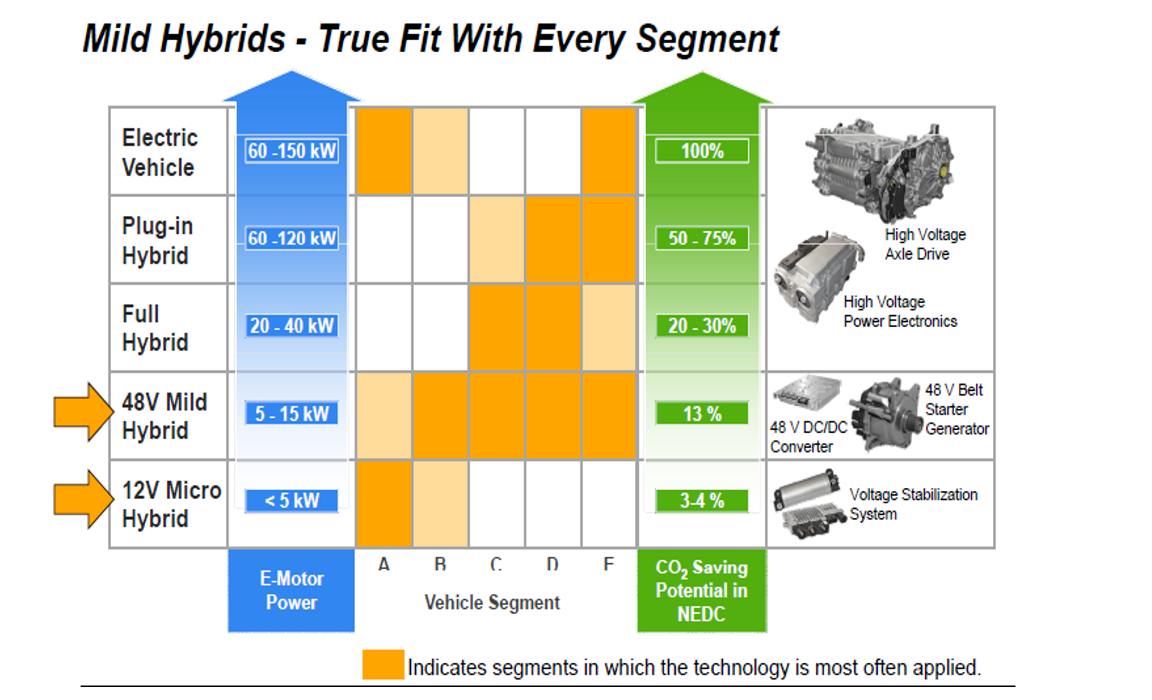
Battery Electric Vehicles (BEVs)
BEVs are also known as All-Electric Vehicles (AEV). Electric Vehicles using BEV technology run entirely on a battery-powered electric drivetrain. The electricity used to drive the vehicle is stored in a large battery pack which can be charged by plugging into the electricity grid. The charged battery pack then provides power to one or more electric motors to run the electric car. To find out more about BEVs, click below.
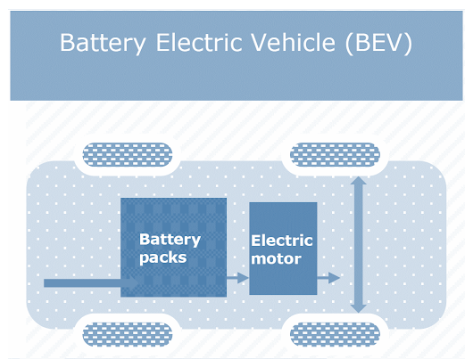
Main Components of BEV:
Electric motor, Inverter, Battery, Control Module, Drive train
Working Principles of BEV:
The power for the electric motor is converted from the DC Battery to AC. As the accelerator is pressed, a signal is sent to the controller. The controller adjusts the speed of the vehicle by changing the frequency of the AC power from the inverter to the motor. The motor then connects and leads to the turning of wheels through a cog. If the brakes are pressed, or the electric car is decelerating, the motor becomes an alternator and produces power, which is sent back to the battery
Hybrid Electric Vehicle (HEV):
HEVs are also known as series hybrid or parallel hybrid. HEVs have both engine and electric motor. The engine gets energy from fuel, and the motor gets electricity from batteries. The transmission is rotated simultaneously by both engine and electric motor. This then drives the wheels. To find out more about HEVs.

Main Components of HEV:
Engine, Electric motor, Battery pack with controller & inverter, Fuel tank, Control module
Working Principles of HEV:
The fuel tank supplies energy to the engine like a regular car. The batteries run on an electric motor. Both the engine and electric motor can turn the transmission at the same time.
Plug-in Hybrid Electric Vehicle (PHEV):
The PHEVs are also known as series hybrids. They have both engine and a motor. You can choose among the fuels, conventional fuel (such as petrol) or alternative fuel (such as bio-diesel). It can also be powered by a rechargeable battery pack. The battery can be charged externally. To find out more about PHEVs.
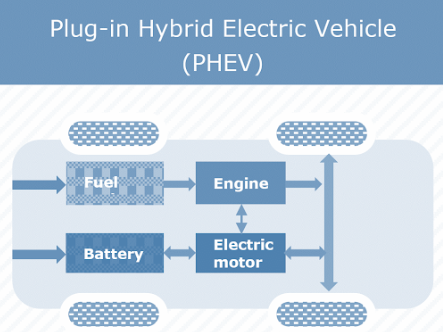
PHEVs can run in at least 2 modes:
- All-electric Mode, in which the motor and battery provide all the car’s energy
- Hybrid Mode, in which both electricity and petrol/diesel are employed
Main Components of PHEV:
Electric motor, Engine, Inverter, Battery, Fuel tank, Control module, Battery Charger (if onboard model)
Working Principles of PHEV:
PHEVs start-up in all-electric mode and make use of electricity until their battery pack is depleted. Once the battery gets drained, the engine takes over, and the vehicle operates as a conventional, non-plug-in hybrid. PHEVs can be charged by plugging into an outside electric power source, engine, or regenerative braking. When brakes are applied, the electric motor acts as a generator, using the energy to charge the battery. The engine’s power is supplemented by the electric motor; as a result, smaller engines can be used, increasing the car’s fuel efficiency without compromising performance.
Fuel Cell Electric Vehicle(FCEV):
FCEVs are also known as Zero-Emission Vehicles. They employ ‘fuel cell technology’ to generate the electricity required to run the vehicle. The chemical energy of the fuel is converted directly into electric energy. To find out more about FCEVs.
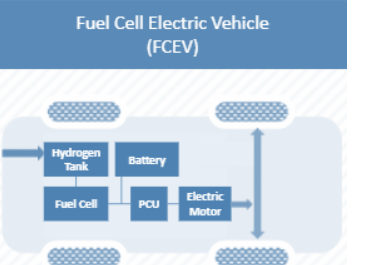
Main Components of FCEV:
Electric motor, Fuel-cell stack, Hydrogen storage tank, battery with converter and controller
Working Principles of FCEV:
The FCEV generates the electricity required to run this vehicle on the vehicle itself.
Examples of FCEV:
Toyota Mirai, Riversimple Rasa, Hyundai Tucson FCEV, Honda Clarity Fuel Cell, Hyundai Nexo.
Key Components of an All-Electric Car

Battery (all-electric auxiliary): In an electric drive vehicle, the auxiliary battery provides electricity to power vehicle accessories.
An electric vehicle uses a battery to store electrical energy that is ready to use. A battery pack is made up of a number of cells that are grouped into modules. Once the battery has sufficient energy stored, the vehicle is ready to use.

Battery technology has improved hugely in recent years. Current EV batteries are lithium based. These have a very low rate of discharge. This means an EV should not lose charge if it isn’t driven for a few days, or even weeks.
Charge port: The charge port allows the vehicle to connect to an external power supply in order to charge the traction battery pack.
The charging port will usually be mounted where the original fuel filler is. It connects directly to the charging system within the car which in turn charges the high-voltage battery pack.
Electric conversions in the UK and Europe usually use Type 2 plugs, which are standardized to ensure the car can be charged up at different places without having to carry around adapters or expensive cables.
Most people don’t realize that you can charge up an electric car conversion using a normal 3-pin socket in the UK. Although slow, this allows you to not worry about finding a charging station. At electric car converts our battery packs can charge from 0-100% in around 8 hours out of a normal plug, although this is just 4 hours if using a purpose-built wall-mounted charging station.
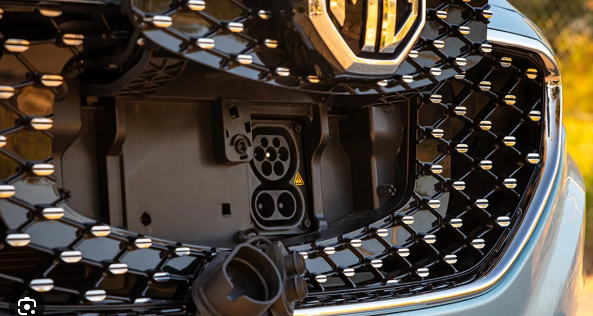
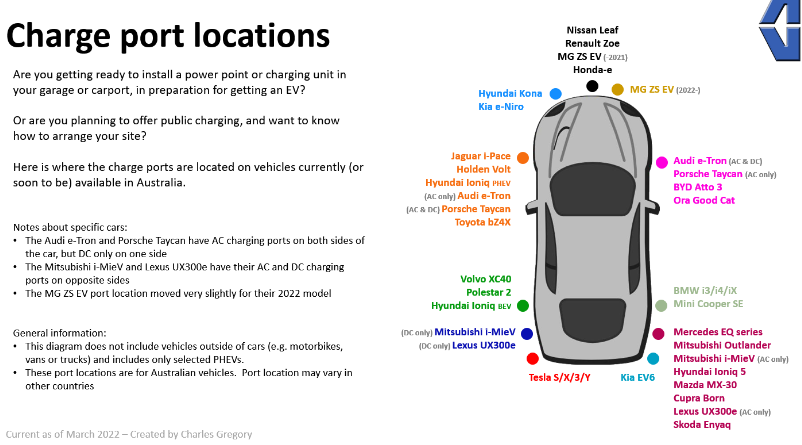
DC/DC converter: This device converts higher-voltage DC power from the traction battery pack to the lower-voltage DC power needed to run vehicle accessories and recharge the auxiliary battery.
The DC/DC (direct current) converter is a device that transforms and changes higher-voltage DC power from the high-voltage battery system to the standard 12V battery required to operate the original 12V system.
This system comprises the lights, wipers, and central locking system for example. It means that upon conversion the car doesn’t have to have its 12V system rewired, which would account for a significant cost.
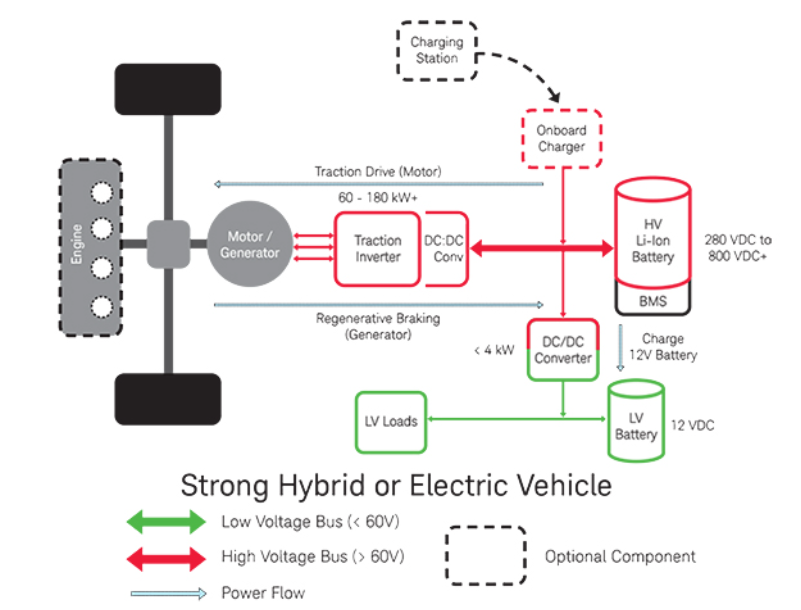
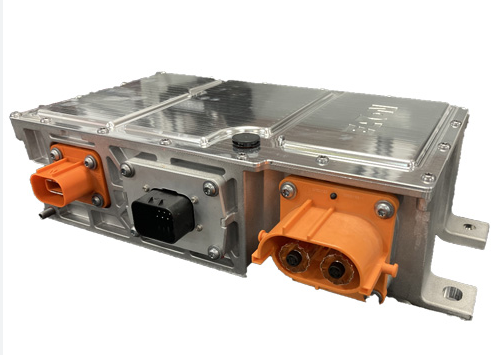
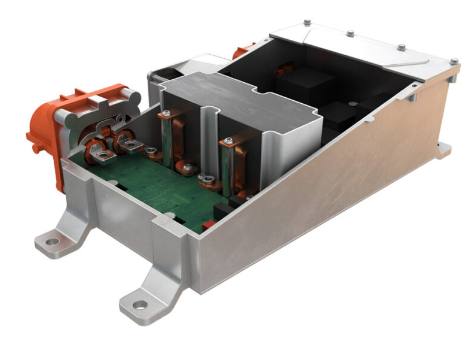
Electric traction motor: Using power from the traction battery pack, this motor drives the vehicle’s wheels. Some vehicles use motor generators that perform both the drive and regeneration functions.
The motor converts electrical energy into mechanical energy to drive the wheels and propel the car. Motors vary hugely, some runoff direct current (DC), some off alternating current (AC). The most common motors for electric vehicle conversions are AC due to them being more efficient. A motor is effectively a large electromagnet that turns due to the attraction and repulsion of the magnets within.
Electric motors convert over 85% of electrical energy to mechanical energy as compared to less than 40% for a gas combustion engine. (Source: NRDC.org)
Electric motors vary in size and power. For example, a motor that could be mounted in an average classic car would be around 120 horsepower, whereas a Tesla large drive unit can generate upwards of 500 horsepower if required.
The motor turns the transmission (gearbox), which can be either the original one or a single speed unit specifically designed for electric power. Using the original gearbox lowers the cost of converting a classic car to electric power as there is little fabrication of new drivetrain components and only adapter plates are required.
However, if using a Tesla drive unit, for example, this has to be mounted across an axle and therefore needs custom half-shafts, differentials, and drivetrains – significantly increasing cost.
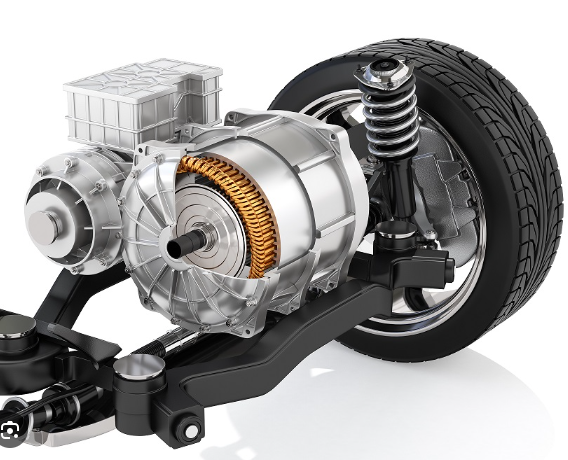
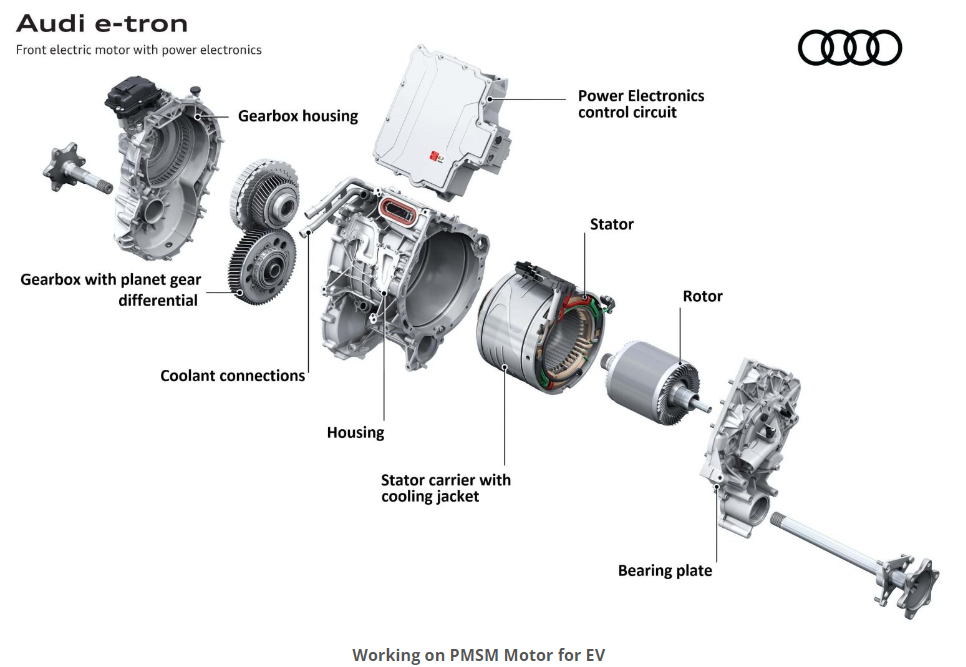

Onboard charger: Takes the incoming AC electricity supplied via the charge port and converts it to DC power for charging the traction battery. It also communicates with the charging equipment and monitors battery characteristics such as voltage, current, temperature, and state of charge while charging the pack.
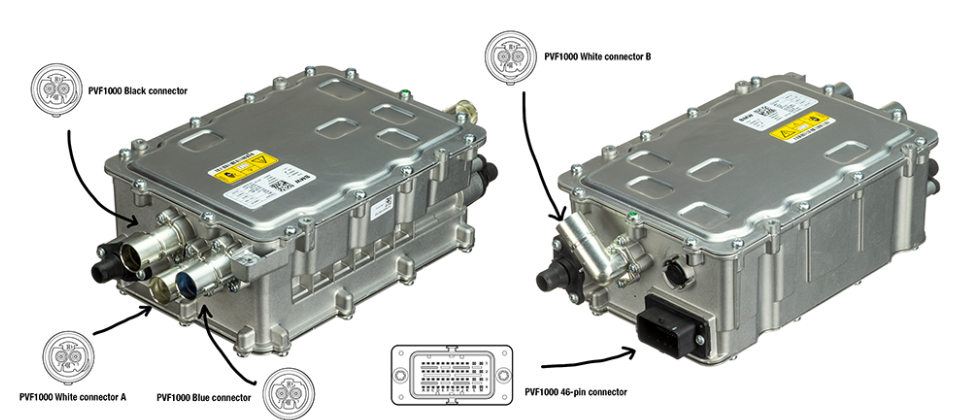
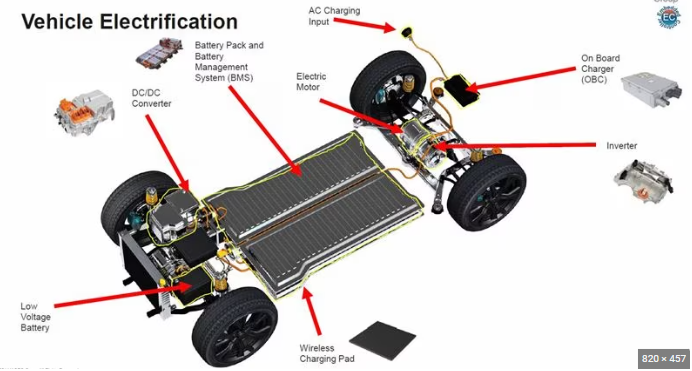
Power electronics controller/Inverter: This unit manages the flow of electrical energy delivered by the traction battery, controlling the speed of the electric traction motor and the torque it produces.
An inverter is a device that converts DC power to the AC power used in an electric vehicle motor. The inverter can change the speed at which the motor rotates by adjusting the frequency of the alternating current. It can also increase or decrease the power or torque of the motor by adjusting the amplitude of the signal.
The inverter (which is also called a motor controller) converts direct current from the batteries to alternating current, which is subsequently delivered to the motor. Think of it as the link between the battery and the motor, without it, the motor would spin at full speed the whole time.
This motor controller will be connected to the throttle of the vehicle as well as the battery management system.
Inverters have a lot of current running through them, particularly if you’re driving quickly, so they’re also linked to the battery cooling system, allowing coolant to keep the temperature manageable.
Finally, the electrical vehicle inverter can convert alternating current to direct current during braking, which can subsequently be utilized to recharge the battery, this is called regenerative braking.

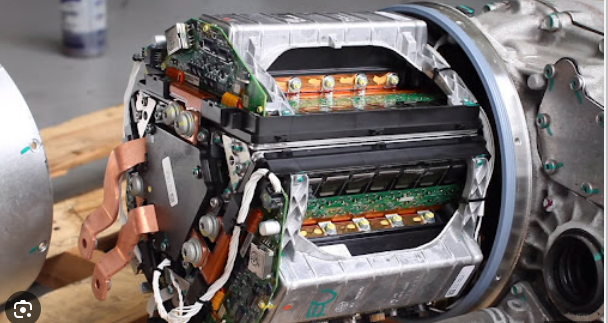
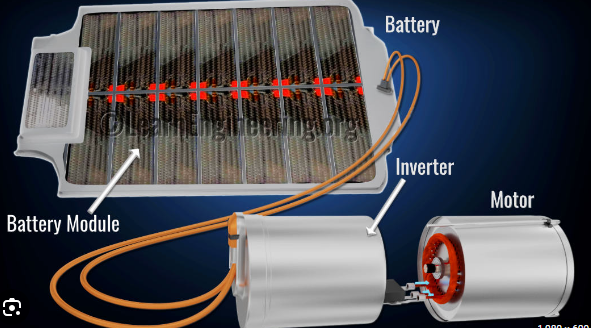
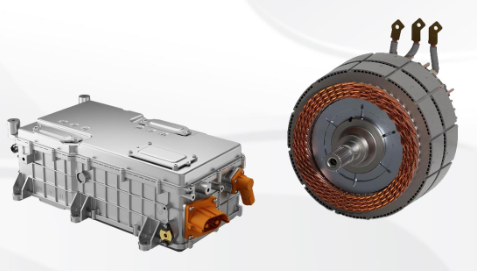
Thermal system (cooling): This system maintains a proper operating temperature range of the engine, electric motor, power electronics, and other components.
Although electric vehicles are 85% efficient, there is still some heat generation, which although is usually not extreme, to protect the components and keep them operating optimally it is best to keep them cool.
Many parts are aircooled, however the batteries and motor controller (inverter) must be kept cool. This thermal system comprises a very small radiator, a fan, a coolant pump and pipes to keep the coolant circulating. It is a closed-loop system that uses fluid to transfer heat away from the heat sensitive components.
The electric car cooling system has three main parts:
1. Radiator: this component cools the coolant fluid within the system.
2. Coolant: this fluid helps to transfer heat away from the electric car components.
3. Fan: this component helps to circulate cool air into the coolant, particularly in slow traffic when air movement is minimal.
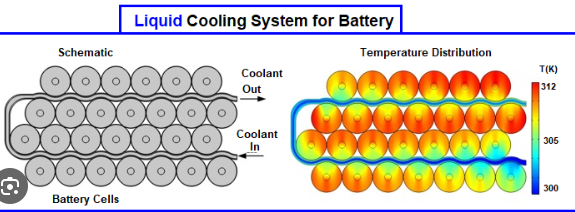
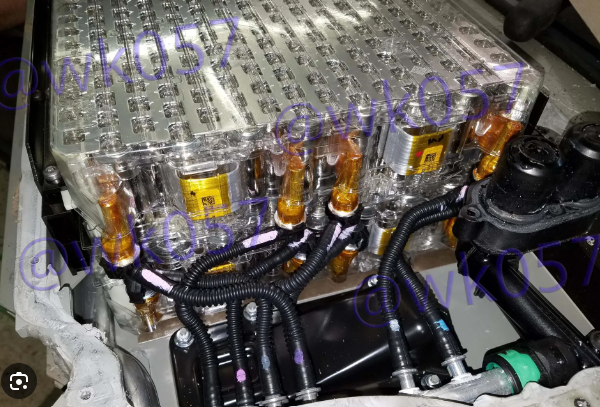
Traction battery pack: Stores electricity for use by the electric traction motor.
The most significant component of an EV is the battery pack. It’s the biggest and most expensive component and ultimately determines how much power and range the vehicle will have. The battery pack is made up of a number of separate batteries that are linked together, this can be anything from 5 to 25 batteries, which each consists of hundreds of individual cells and usually come out of production electric vehicles.
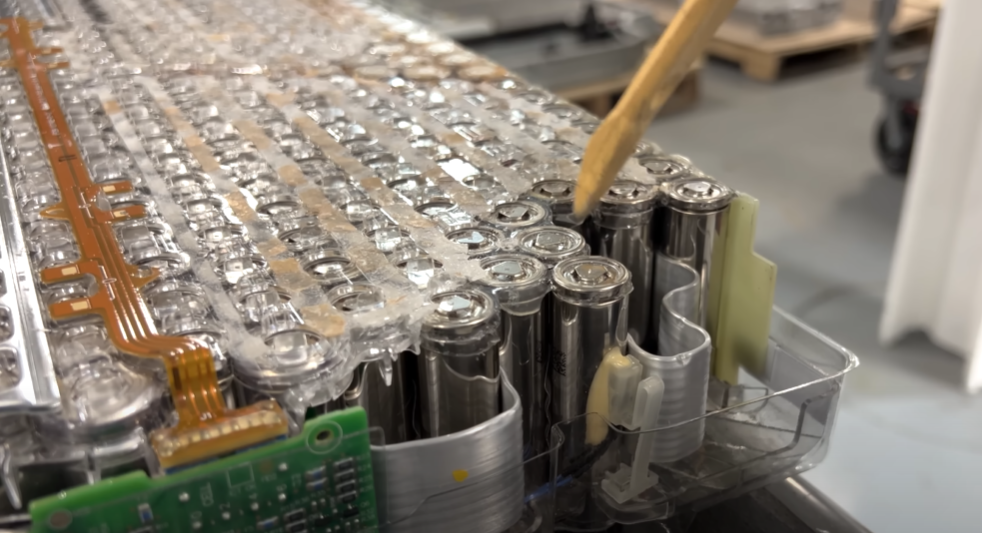
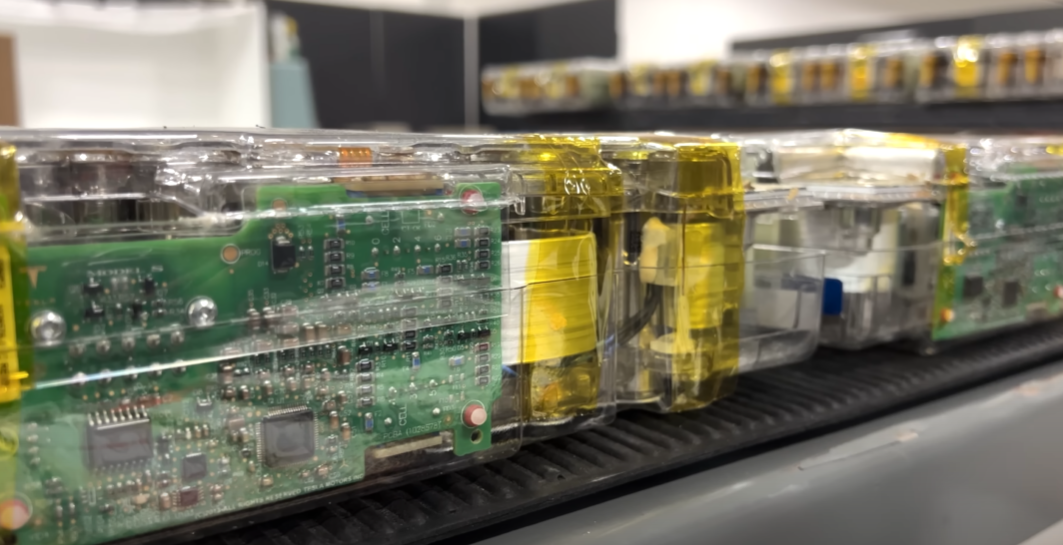
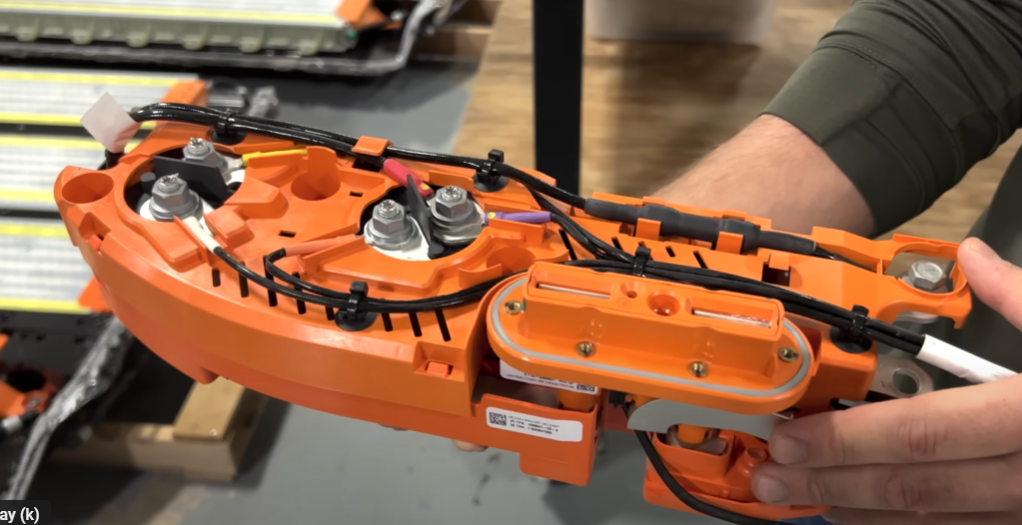
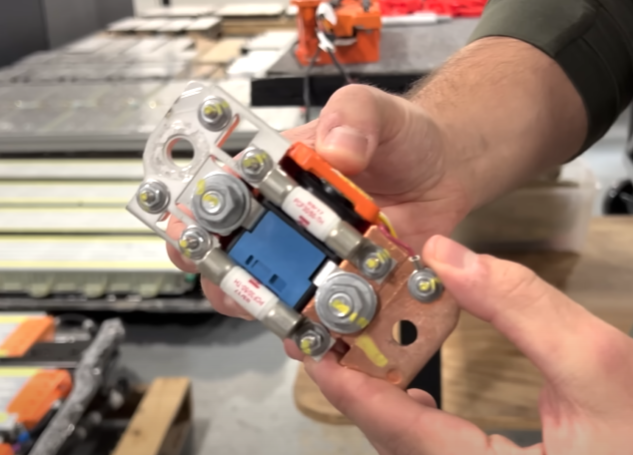

The battery pack will be housed in a custom-built metal battery box which is designed to fit into the original engine bay of the classic vehicle. If more batteries are required for additional range, a second battery box can be installed somewhere else (in the boot or under the back seats for example).
In this battery box are all of the electronic components which control and monitor the pack. For example, an ignition system will open and close switches to turn the car off and on.
Also within the battery box is the battery management system (BMS) which monitors voltages, temperatures, and the current running through the pack whilst charging and discharging, ensuring that the battery is not damaged by excessive temperatures or voltages.
This BMS links to the charging system and motor controller, constantly sending and receiving signals to ensure that the battery pack is operating optimally.
Finally, the battery box has a cooling system running through it connected to an external radiator and water pump. This cooling system runs coolant inside each battery within the pack to ensure that all batteries are running at the same temperature and that this doesn’t get too high, which would in turn limit the motor output
Transmission (electric): The transmission transfers mechanical power from the electric traction motor to drive the wheels.

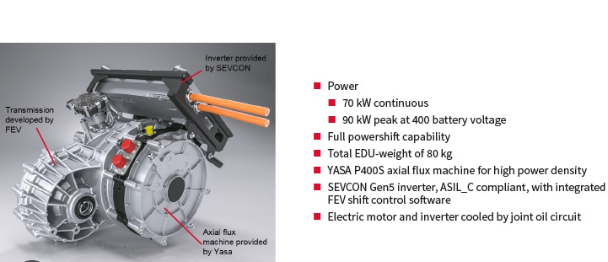
How electric vehicles move
EV’s are like an automatic car. They have a forward and reverse mode. When you place the vehicle in gear and press on the accelerator pedal these things happen:
- Power is converted from the DC battery to AC for the electric motor
- The accelerator pedal sends a signal to the controller which adjusts the vehicle’s speed by changing the frequency of the AC power from the inverter to the motor
- The motor connects and turns the wheels through a cog
- When the brakes are pressed or the car is decelerating, the motor becomes an alternator and produces power, which is sent back to the battery
AC/DC and electric cars
AC stands for Alternating Current. In AC, the current changes direction at a determined frequency, like the pendulum on a clock.
DC stands for Direct Current. In DC, the current flows in one direction only, from positive to negative.
How does an Electric Car work?
Instead of an internal combustion engine, electric cars are propelled by an electric motor. The motor is powered by a high-voltage battery pack which feeds electricity to the motor based on how far you push the accelerator pedal.
When the vehicle’s accelerator pedal is pressed, the following happens:
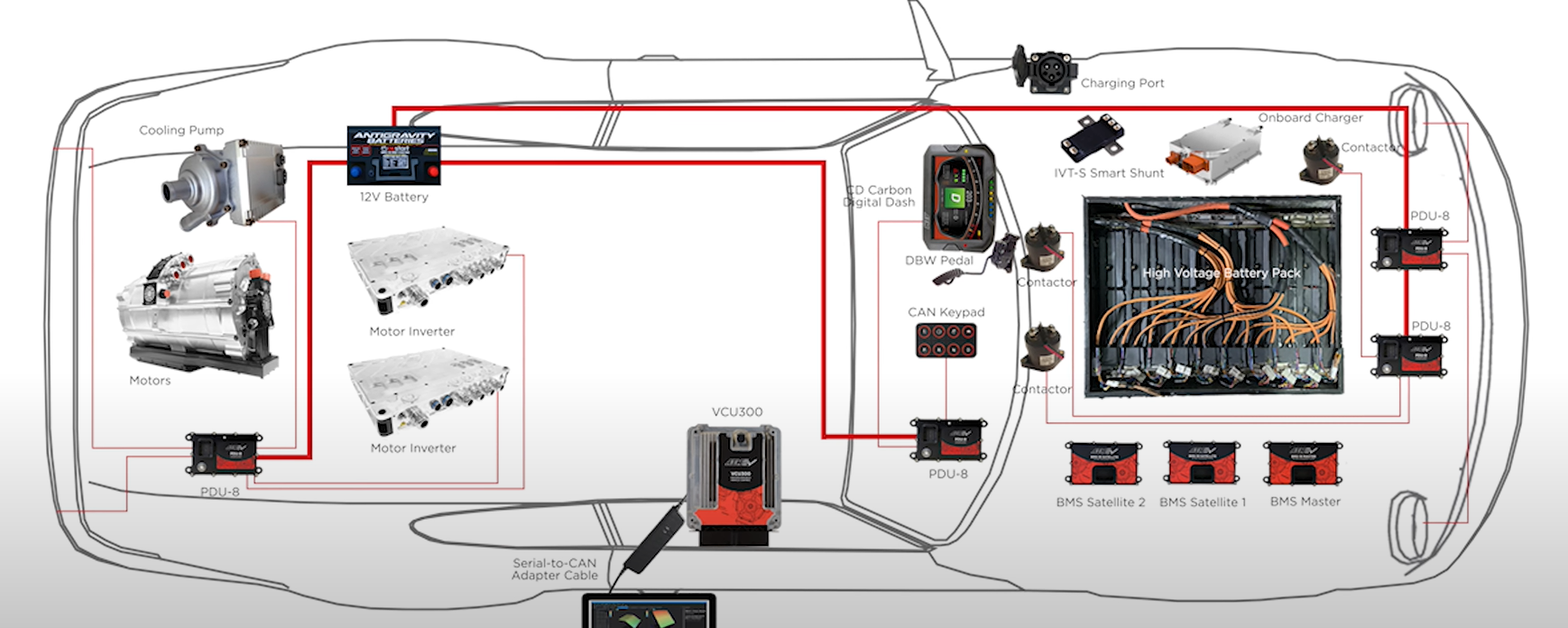
- The motor controller (inverter), as the brain of the operation, receives the input and calculates how much power is needed from the battery pack.
- The inverter then sends an amount of electrical energy to the motor based on how hard the pedal is pushed.
- Electrical energy is converted into mechanical (rotational) energy by the motor using electromagnets and wire coils.
- The output shaft on the motor rotates inside the transmission.
- The transmission adjusts this rotation into a speed that can be used by the rest of the drivetrain (axles, differentials, driveshafts etc) causing the wheels to turn and the car to move.
Division of Architecture system
1.High Voltage system
2.Low Voltage system
High voltage System: contains following components .
A Pot-box is the short name for the potentiometer box in an EV. It’s the device that your accelerator cable is attached to in order to regulate how much power will be allowed to the motor.
Pot boxes come in the form of the PB-2 and the PB-6 pot box throttle EV controller component. A pot box throttle tells the controller how much current is needed to be sent to the motor. The box translates foot pressure into a variable resistance to let the controller know how fast you want to go.
A high-voltage contactor, also called a high-voltage relay without distinction in the industry, is widely used in
electric vehicles (EV) and hybrid electric vehicles (HEV). It is an electromechanical switching device with a coil to
generate a magnetic force that mechanically operates an electric contact. However, it is more common to use a
high-voltage contactor to represent high-power applications in EV and HEVs.
The battery and the traction inverter are electrically isolated by main contactors when the vehicle is switched off
for safety reasons. The main positive contactor is between the positive battery pole and the traction inverter
while the main negative contactor is between the negative battery pole and the traction inverter. Both these
contactors are required for safety robustness. The pre-charge contactor with a series current-limiting resistor is
in parallel with the main positive contactor and used to charge the initially discharged DC link capacitor before
closing the main contactors to avoid the high inrush current which might damage the battery, power contactors,
and DC link capacitor. The two main contactors and one pre-charge contactor comprise an indispensable
configuration for full HEVs.
In plug-in HEVs, a pair of additional AC charge contactors is inserted to establish a connection between the
traction battery and the onboard charger. The onboard charger of the vehicle gets power from an AC charger,
converts that AC power to DC to charge the battery.
For battery EVs, another pair of DC fast charge contactors is inserted to establish a connection between the
traction battery and the DC fast-charge equipment. The DC fast charging is essential for long distance driving
and large battery EV fleets. An auxiliary contactor like the electric heater for the passenger compartment is
mandatory because there is no waste heat available from a combustion engine.
Main contactors, pre-charge contactors, and DC charge contactors are mostly located in the battery junction box
(or battery disconnect unit). AC charge contactors are likely to be placed in the battery power distribution unit
which is adjacent to the onboard charger
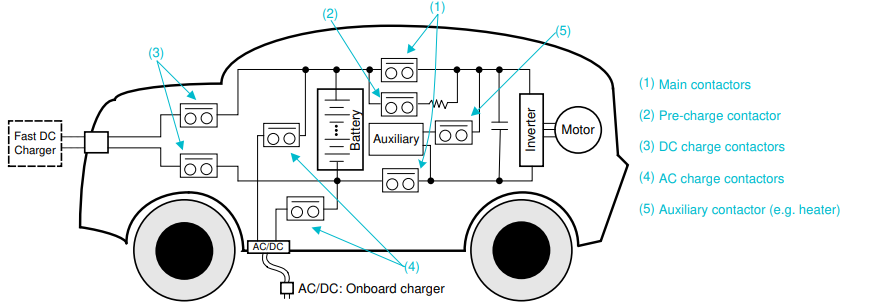
- High voltage Battery Pack
- Contactors
- Motor Invertor
- Onboard Charger
- Charging Port
- ITV smart
- Motor
Battery Packs come with 200 V to 800Volt
DC-DC converts acts as a Alternator to charge the Auxiliary battery which provides the Energy to accessories.
Low voltage system: Its similar to ICE engine system.
